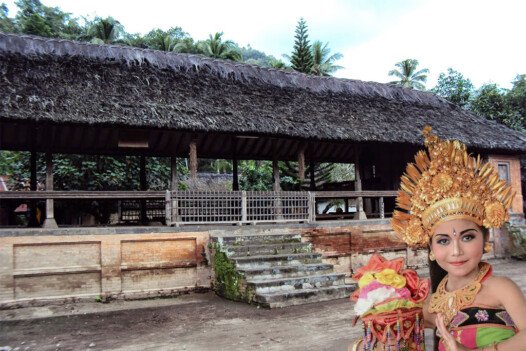When most travelers think of Bali, they imagine beach clubs in Seminyak, the rice terraces of Ubud, or the surf-friendly waves of Canggu. Yet Bali is more than just its Instagram-famous highlights. Beyond the crowds and commercialized attractions, there exists a different kind of Bali — one filled with quiet villages, ancient rituals, untouched coastlines, and an authenticity that speaks directly to the soul of the island.
This article takes you off the beaten path to explore the hidden treasures of “Alternative Bali.”
🏡 1. Discovering Bali’s Authentic Villages
Far from the modernized resorts and tourist centers, Bali’s traditional villages, or desa adat, are where the island’s cultural heart continues to beat strong. Here, you’ll witness customs, ceremonies, and ways of life unchanged for centuries.
📍 Sidemen: The Soul of East Bali
Tucked away in the rolling hills of East Bali, Sidemen is a peaceful village framed by lush rice terraces and views of Mount Agung. Unlike its popular neighbor Ubud, Sidemen has maintained a quiet charm. Life here moves to the rhythm of nature — farmers tending to their fields, women weaving songket, and daily offerings made to ancestral spirits.
Hiking trails lead you through emerald landscapes, across bamboo bridges, and to hidden waterfalls. You’ll find family-run homestays instead of large hotels, and locally sourced food lovingly prepared in home kitchens.
🕯️ Tenganan Pegringsingan: The Ancient Bali Aga
Located near Candidasa, Tenganan is one of the last strongholds of the Bali Aga — the island’s indigenous people. The village is famous for its strict customs, unique architecture, and the intricate double ikat weaving technique, practiced by only a handful of communities worldwide.
Visitors can walk through its symmetrical stone paths and traditional houses, observe sacred ceremonies, and speak with artisans continuing ancient traditions.
🧘♀️ 2. Sacred Stillness: Spiritual Retreats Away from the Noise
While Ubud is known as Bali’s spiritual hub, it’s also teeming with traffic and tourists. Lesser-known places offer more intimate and deeply spiritual experiences.
🌿 Munduk: Mountain Mist and Meditation
Perched in North Bali’s highlands, Munduk is a haven of misty forests, clove plantations, and serenity. It’s perfect for meditation, yoga, and mindfulness retreats. Some retreats are located on hilltops where sunrise yoga sessions are accompanied by birdsong and panoramic views of Lake Tamblingan.
Waterfalls like Munduk and Melanting flow nearby, offering natural spaces for contemplation and quiet connection with nature.
🔮 Seraya: A Sacred Coastal Escape
On Bali’s eastern tip lies Seraya, a tranquil coastal village untouched by mass tourism. Home to cliffside temples, sacred springs, and fishermen living by the lunar tides, Seraya feels frozen in time.
Some boutique retreats and eco-villas offer spiritual workshops, Balinese purification rituals, and silent meditative walks through nearby black-sand beaches and volcanic hills.
🚣♂️ 3. Hidden Shores: Bali’s Secluded Beaches and Coastal Secrets
While Kuta and Sanur buzz with activity, there are still remote beaches where the sea whispers instead of roars.
🏖️ Amed: Black Sand and Underwater Temples
Amed’s volcanic coastline is a paradise for those seeking peace and natural beauty. Its beaches are black with volcanic ash, and the shallow coral reefs are filled with life — perfect for snorkeling and freediving.
The Japanese Shipwreck and the submerged underwater temple garden near Jemeluk Bay are lesser-known gems. Here, local families still fish using traditional wooden boats called jukung, and sunsets paint the water in molten gold.
🌅 Nyang Nyang Beach: A Hidden Cliffside Treasure
Accessible only by a steep stairway down a forested cliff, Nyang Nyang Beach is a long stretch of white sand framed by turquoise waves and absolute seclusion. Unlike the crowded shores of Kuta or Jimbaran, this beach feels wild and free.
There are no vendors, no music, and no deck chairs — just the whisper of waves and the scent of salty air. Come early, bring your supplies, and let nature do the rest.
🏺 4. Cultural Immersion Over Commodification
Bali’s charm lies in its rituals, traditions, and the belief that the physical and spiritual worlds are deeply connected. To truly understand Bali, travelers must move beyond sightseeing into mindful cultural immersion.
🎭 Witnessing Real Ceremonies
Instead of paying for commercial dance shows in Ubud, time your visit with actual temple festivals (odalan), cremation ceremonies (ngaben), or the majestic Balinese Day of Silence (Nyepi). These ceremonies are deeply spiritual and reflect a philosophy of balance — between good and evil, the visible and the unseen.
Villagers often welcome respectful observers, especially if you wear traditional clothing (sarong and sash) and ask permission before entering temple grounds.
🧵 Learning Traditional Arts
Take part in a batik class in Tabanan, learn to cook Balinese dishes with grandmothers in Klungkung, or attend a woodcarving workshop in Mas. These experiences give you a hands-on connection with Bali’s cultural legacy.
It’s not about collecting souvenirs — it’s about understanding the stories behind them.
🥾 5. Hiking Into the Heart of the Island
Bali’s mountains are considered sacred, and hiking them offers not only physical challenge but spiritual reward.
🏔️ Mount Batukaru: The Silent Giant
Unlike the popular Mount Batur sunrise trek, Mount Batukaru remains relatively untouched. It’s the second-highest peak in Bali and is covered in dense, mossy jungle. The climb is challenging and often mist-shrouded, with few tourists on the trail.
At its base lies the Pura Luhur Batukaru, a temple shrouded in fog and mystery — one of the island’s most sacred sites.
🪵 Jatiluwih Rice Terraces: A Walk Through Living History
A UNESCO World Heritage Site, the Jatiluwih rice terraces represent the subak irrigation system — a centuries-old method guided by religious philosophy. The trails here are expansive and meditative, weaving through vibrant paddies that stretch to the horizon.
It’s not just a landscape — it’s a living canvas of human-nature harmony.
🌌 6. Sleeping with Nature: Eco-Stays and Homestays
In alternative Bali, accommodation isn’t about luxury — it’s about connection. Whether you’re staying in a bamboo hut on stilts or a family compound, the experience is immersive.
🌾 Eco-Lodges in West Bali
West Bali National Park offers jungle ecolodges surrounded by wildlife and untouched rainforest. Here, you’ll sleep to the calls of macaques and wake with deer grazing nearby. Snorkel the nearby Menjangan Island, a protected marine sanctuary.
👨👩👧👦 Homestays in Bangli and Karangasem
Family-run homestays invite you to be part of daily life — from morning prayers to harvesting vegetables, and sharing meals around the fire. Many hosts also offer to teach Balinese language, traditional cooking, or how to make canang sari offerings.
It’s slow, sincere, and the best way to form real human connections.
🌀 7. Responsible Travel and Mindful Exploration
Alternative Bali isn’t just about going to quieter places — it’s about traveling with intention.
🌍 Supporting Local Economies
By choosing local guides, eating at warungs, staying in family-run guesthouses, and purchasing directly from artisans, you help preserve culture and empower communities.
♻️ Sustainable Choices
Avoid plastic bottles, respect natural spaces, and say no to animal tourism. Organizations like Bye Bye Plastic Bags and Sungai Watch are leading the charge in Bali — and you can be part of the solution too.
🙏 Cultural Sensitivity
Dress modestly in temples, ask permission before photographing people, and learn a few basic Balinese greetings like “Om Swastiastu.” A little respect goes a long way.
🌅 Final Thoughts: The Real Bali Beckons
The Bali most travelers see is just the surface — the real magic lies deeper, in its quiet villages, sacred mountains, and soulful people. By stepping off the tourist trail and into the heart of the island, you don’t just find new places — you discover a deeper kind of journey, one that transforms both traveler and host.
Alternative Bali is not for those chasing checklists. It’s for those who listen, observe, and open themselves to the sacred rhythm of an island that still remembers who it is.









